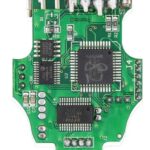Data Logging Vcds is crucial for diagnosing vehicle performance and identifying potential issues, especially in tuned cars. At CAR-CODING.EDU.VN, we understand the complexities of modern automotive coding and offer expert remote support to streamline your diagnostic processes and enhance your capabilities. Our services provide immediate assistance for complex coding tasks, helping you activate hidden features and resolve stubborn fault codes efficiently.
Contents
- 1. What is Data Logging with VCDS, and Why is it Important?
- 1.1. Why is Data Logging Essential for Modern Vehicles?
- 1.2. What Role Does VCDS Play in Data Logging?
- 2. Who Benefits from Data Logging with VCDS?
- 2.1. How Can Experienced Automotive Technicians Benefit from Data Logging?
- 2.2. How Can Specialists in Specific Vehicle Brands Benefit from Data Logging?
- 2.3. How Can Garage Owners Benefit from Data Logging?
- 3. Understanding the Core Concepts of Data Logging with VCDS
- 3.1. What is ECU Programming?
- 3.2. What is Car Coding?
- 3.3. What is ECU Flashing?
- 3.4. What Does Activating Hidden Features Mean?
- 4. Step-by-Step Guide to Data Logging with VCDS
- 4.1. Initial Setup
- 4.2. Checking for Fault Codes
- 4.3. Setting Up Logging Parameters
- 4.4. Initiating Logging
- 4.5. Analyzing Logged Data
- 5. Advanced Data Logging Techniques
- 5.1. Logging Misfires
- 5.2. Logging Lambda/Air:Fuel/EGT
- 5.3. Logging Fuel Pressures, Trims, and Injectors
- 6. Troubleshooting Common Data Logging Issues
- 6.1. Low Resolution Logging
- 6.2. Communication Errors
- 7. The Benefits of Remote Car Coding Assistance
- 7.1. Expert Guidance
- 7.2. Time Savings
- 7.3. Cost-Effectiveness
- 8. How CAR-CODING.EDU.VN Enhances Your Data Logging Capabilities
- 8.1. Remote Support
- 8.2. Specialized Expertise
- 8.3. Comprehensive Solutions
- 9. Real-World Applications of Data Logging and Remote Support
- 9.1. Resolving Intermittent Performance Issues
- 9.2. Optimizing Vehicle Tuning
- 9.3. Activating Hidden Features
- 10. Frequently Asked Questions About Data Logging with VCDS
- 10.1. Is Data Logging with VCDS Safe?
- 10.2. What Equipment Do I Need to Perform Data Logging?
- 10.3. How Much Does Remote Support for Data Logging Cost?
- 10.4. What Types of Vehicles Can Be Logged with VCDS?
- 10.5. Can Data Logging Help Identify Fueling Issues?
- 10.6. How Do I Interpret the Data Logged with VCDS?
- 10.7. What Are the Benefits of Grouping UDS Requests When Logging?
- 10.8. Can I Log Data While Driving?
- 10.9. What Do I Do if I Encounter Communication Errors During Logging?
- 10.10. How Can Remote Support Help with Complex Coding Tasks?
1. What is Data Logging with VCDS, and Why is it Important?
Data logging with VCDS (VAG-COM Diagnostic System) involves recording various parameters of a vehicle’s engine and other systems while it’s running. This data helps technicians analyze performance, diagnose issues, and optimize tuning. CAR-CODING.EDU.VN emphasizes that accurate data logging is essential for identifying anomalies and ensuring the vehicle operates within safe parameters. This process is particularly important for vehicles with modified ECUs or those experiencing performance problems.
1.1. Why is Data Logging Essential for Modern Vehicles?
Modern vehicles are equipped with numerous sensors and complex electronic control units (ECUs). Data logging allows technicians to monitor these components in real-time, providing insights into how the vehicle behaves under different conditions. Without data logging, diagnosing intermittent issues or optimizing performance modifications becomes significantly more challenging. CAR-CODING.EDU.VN’s remote support leverages data logging to provide precise and effective solutions, saving time and reducing the risk of misdiagnosis.
1.2. What Role Does VCDS Play in Data Logging?
VCDS is a diagnostic tool developed by Ross-Tech, specifically designed for Volkswagen Audi Group (VAG) vehicles. It allows technicians to access and log data from various control modules within the car. VCDS is known for its user-friendly interface and comprehensive diagnostic capabilities, making it an indispensable tool for automotive professionals. CAR-CODING.EDU.VN utilizes VCDS extensively in its remote support services to ensure accurate and reliable data analysis for its clients.
2. Who Benefits from Data Logging with VCDS?
Data logging with VCDS is beneficial for a wide range of automotive professionals, including experienced technicians, specialists in specific vehicle brands, and garage owners looking to expand their service offerings. CAR-CODING.EDU.VN caters to these diverse needs by providing expert remote support, ensuring that technicians can effectively use VCDS to diagnose and optimize vehicle performance, regardless of their experience level.
2.1. How Can Experienced Automotive Technicians Benefit from Data Logging?
Experienced technicians can leverage data logging to enhance their diagnostic skills and tackle complex issues more efficiently. By recording and analyzing vehicle parameters, they can identify subtle anomalies that might be missed through traditional diagnostic methods. CAR-CODING.EDU.VN supports experienced technicians by providing advanced coding and programming assistance, enabling them to offer specialized services to their clients.
2.2. How Can Specialists in Specific Vehicle Brands Benefit from Data Logging?
Technicians specializing in brands like BMW or Mercedes-Benz can use data logging to gain deeper insights into the specific systems and components of these vehicles. This allows them to fine-tune performance and address brand-specific issues effectively. CAR-CODING.EDU.VN offers specialized support for various vehicle brands, ensuring that technicians have access to the expertise needed to excel in their chosen niche.
2.3. How Can Garage Owners Benefit from Data Logging?
Garage owners can expand their service offerings by incorporating data logging and advanced diagnostics. This not only attracts more customers but also positions the garage as a leader in automotive technology. CAR-CODING.EDU.VN assists garage owners by providing comprehensive remote support, enabling their staff to perform complex coding and programming tasks with confidence.
3. Understanding the Core Concepts of Data Logging with VCDS
To effectively use data logging with VCDS, it’s crucial to understand the core concepts involved, including ECU programming, coding, flashing, and activating hidden features. CAR-CODING.EDU.VN provides detailed explanations and expert guidance on these topics, ensuring that technicians have a solid foundation for advanced diagnostics and vehicle optimization.
3.1. What is ECU Programming?
ECU (Engine Control Unit) programming involves modifying the software that controls a vehicle’s engine and other systems. This can be done to improve performance, enhance fuel efficiency, or customize vehicle behavior. CAR-CODING.EDU.VN offers professional ECU programming services, ensuring that modifications are performed safely and effectively.
3.2. What is Car Coding?
Car coding refers to the process of changing a vehicle’s software to enable or disable certain features. This can include activating hidden features, adjusting settings, or adapting components after replacement. CAR-CODING.EDU.VN provides expert coding assistance, allowing technicians to tailor vehicles to meet their customers’ specific needs.
3.3. What is ECU Flashing?
ECU flashing involves overwriting the existing software on an ECU with a new version. This is often done to update the ECU with the latest software patches or to install a custom tune. CAR-CODING.EDU.VN offers ECU flashing services, ensuring that the process is performed correctly and without risking damage to the ECU.
3.4. What Does Activating Hidden Features Mean?
Many vehicles have hidden features that are not enabled by default. Activating these features can enhance the vehicle’s functionality and provide additional convenience for the driver. CAR-CODING.EDU.VN specializes in activating hidden features, offering a range of customization options for various vehicle brands.
4. Step-by-Step Guide to Data Logging with VCDS
Data logging with VCDS involves several steps, from connecting the cable to analyzing the collected data. CAR-CODING.EDU.VN provides a detailed step-by-step guide to help technicians perform data logging accurately and efficiently.
4.1. Initial Setup
- Connect the VCDS Cable: Plug the Ross-Tech VCDS cable into the OBDII port under the dashboard on the driver’s side.
- Launch the VCDS Software: With the car turned on, launch the VCDS software on your Windows-based computer.
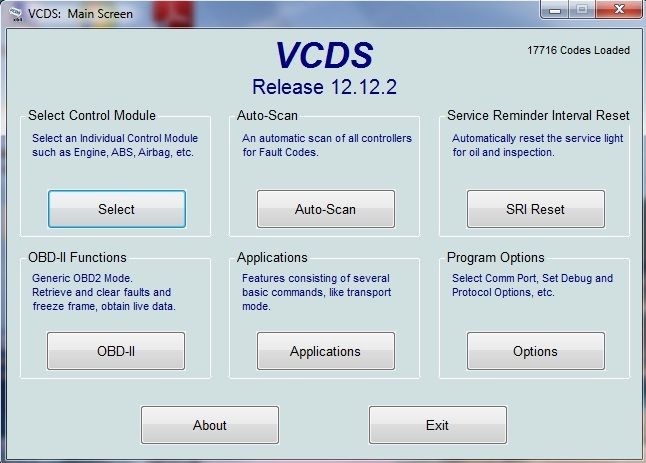 Connecting VCDS cable to OBDII port for car diagnostics
Connecting VCDS cable to OBDII port for car diagnostics
4.2. Checking for Fault Codes
- Auto-Scan: In the VCDS main menu, click the “Auto-Scan” button to check for any existing fault codes.
- Start Scan: Press the “Start” button to begin the scanning process. This may take a few minutes as the software scans all modules.
- Save and Clear Faults: If any faults are found, save the scan results and clear the faults by clicking the “Clear all DTC’s” button.
- Close Auto-Scan: Once the faults are cleared, close the Auto-Scan section and return to the main menu.
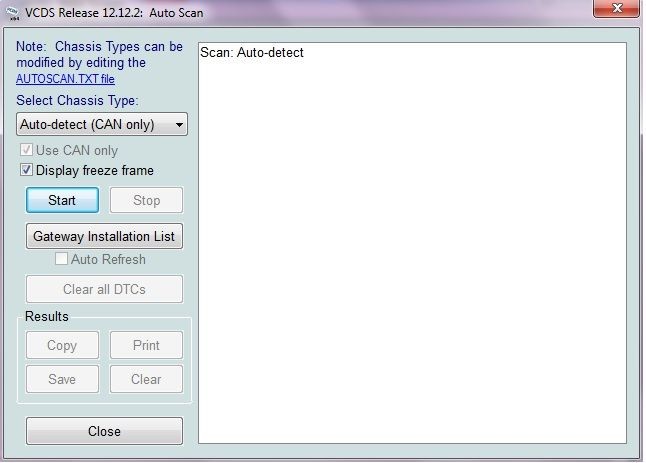 VCDS auto scan interface for fault code detection
VCDS auto scan interface for fault code detection
4.3. Setting Up Logging Parameters
- Select Control Module: In the main menu, click the “Select” button under “Select Control Module.”
- Choose Engine Module: Under the “Common” tab, click the “01-Engine” module button.
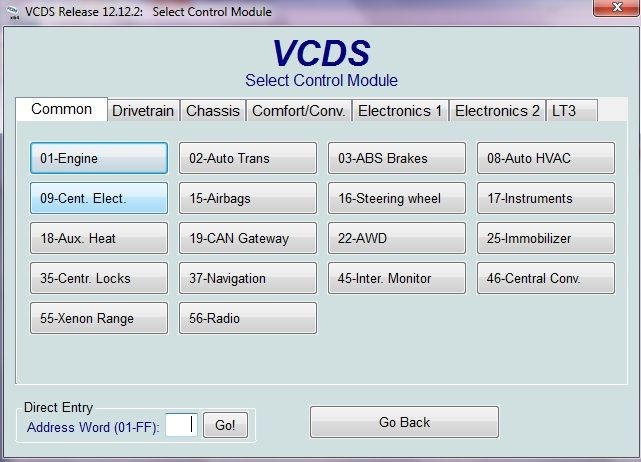 VCDS control module selection interface showing engine module option
VCDS control module selection interface showing engine module option
-
Access Advanced Measuring Values: In the Engine Controller module, click the “Adv. Meas. Values” button to access the logging section.
-
Record Ambient Air Pressure: Select the “Ambient Air Pressure” value from the parameter list and record the displayed value for later use. Then, uncheck the box.
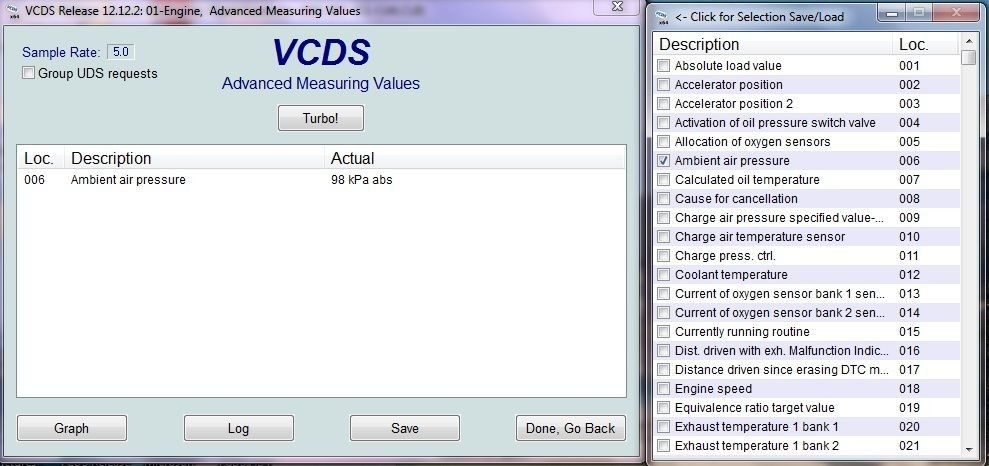 VCDS interface displaying ambient air pressure value
VCDS interface displaying ambient air pressure value
-
Select Logging Parameters: Choose the parameters you want to log from the list. VCDS allows a maximum of 12 parameters, or 10 if using grouping.
-
Recommended Parameters for B8 Models:
- 002: Accelerator position (in %)
- 009: Charge air pressure specified value (in hPa)
- 018: Engine speed (in RPM)
- 089: Air mass (in kg/h)
- 186: Ignition angle; actual (in degrees)
- 188: Intake air temperature (in degrees C)
- 190: Intake manifold pressure; absolute (in hPa)
- 418-423: IGA_AD_KNK[0-5] (in degrees; knock detection/timing pulled on cylinders 1-6)
- 540: RFP_AV (bypass valve %)
-
Recommended Parameters for B8.5 Models:
- Group 2: Accelerator position (%)
- Group 11: Charge air pressure specified value (hPa)
- Group 24: Engine speed (rpm)
- Group 134: Air mass (kg/h)
- Group 226: Ignition angle; actual (degrees)
- Group 228: Intake air temperature (in degrees C)
- Group 230: Intake manifold pressure; absolute (hPa)
- Group 480-485: IGA_AD_1_KNK_x (knock correction in degrees; x is cylinder number 0-5)
- Group 616: RFP_AV (bypass valve %)
-
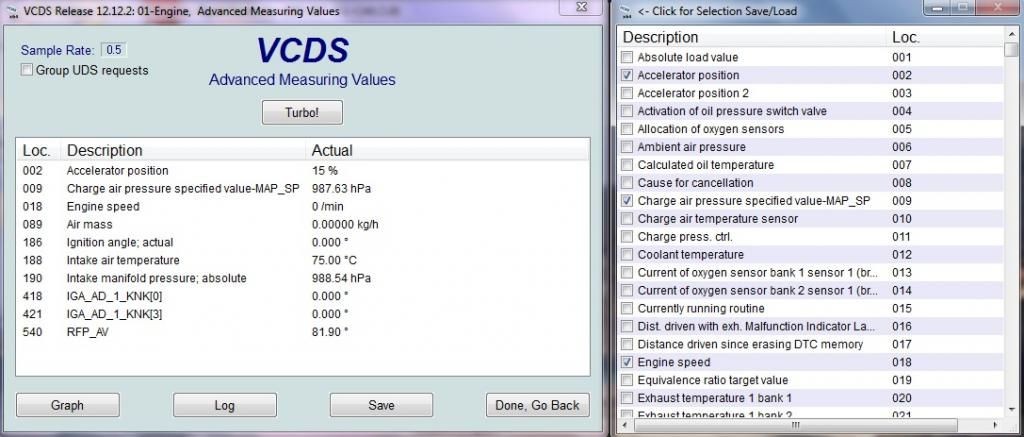 VCDS logging fields selection interface for performance monitoring
VCDS logging fields selection interface for performance monitoring
- Save Parameter List: Save the selected parameter list by clicking the “VCDS” icon and naming the file appropriately (e.g., “performance”).
4.4. Initiating Logging
- Enable Turbo Mode and Group UDS Requests: Click the “Turbo” button and check the “Group UDS requests” box. This speeds up logging and ensures accurate data collection.
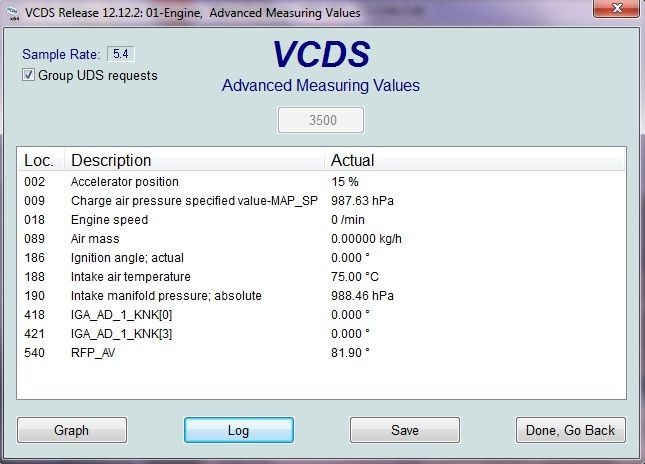 VCDS logging interface with Turbo button and Group UDS requests enabled
VCDS logging interface with Turbo button and Group UDS requests enabled
-
Start Logging: Click the “Log” button to initiate the logging session.
-
Begin Data Capture: Press the “Start” button to begin the actual logging process. Ensure the car is running.
- Logging Environment: Perform logging in a safe and controlled area.
- Gear Pull: Capture a full 3rd gear pull (3000 RPM to 7000 RPM) at a minimum. 4th gear pulls are better but should only be done on a drag strip or dyno.
- Vehicle Settings: Turn off A/C and radio, close windows, set the car to dynamic mode (if available), and disable traction/ASR.
- Surface Conditions: Log on a flat surface, and repeat logs in similar conditions for accurate data comparison.
-
Stop Logging: Once you have captured the necessary data, click the “Stop” button to stop the logging process.
-
Save Logs: Click “Done, close” to save the logs. The files are saved as .CSV files in the Ross-Tech/VCDS/Logs folder.
4.5. Analyzing Logged Data
The logged data can be opened with Excel or similar spreadsheet software. Analyzing this data requires understanding the parameters and their expected values. CAR-CODING.EDU.VN provides support in interpreting log data, helping technicians identify potential issues and optimize vehicle performance.
5. Advanced Data Logging Techniques
In addition to basic performance logging, VCDS offers the ability to log many other parameters, allowing for more specific diagnostics. CAR-CODING.EDU.VN provides guidance on advanced logging techniques, enabling technicians to address a wider range of issues.
5.1. Logging Misfires
If you are experiencing misfires, logging misfires on all cylinders can help pinpoint the source of the problem. Recommended parameters include:
- Accelerator position
- Engine speed
- Misfires all cylinders per 1000 rpm
- Misfires cylinder X per 1000 rpm (for all 6 cylinders)
5.2. Logging Lambda/Air:Fuel/EGT
Logging Lambda or Air:Fuel ratio is crucial for ensuring optimal engine tuning, especially with aftermarket tunes. Key parameters to log include:
- Exhaust temperature bank 1 & 2
- Lambda probes actual bank 1 & 2
- Lambda probes specified bank 1 & 2
5.3. Logging Fuel Pressures, Trims, and Injectors
Monitoring fuel pressures, trims, and injector performance can help diagnose fueling issues, especially when running E85 or pushing the fuel system to its limits. Important parameters to log include:
- Rail pressure actual & specified
- Fuel pressure
- Fuel pump, actual fuel pressure
- Long-term adaptation bank 1 & 2
- Short-term adaptation bank 1 & 2
- Injector Pulse Width (IPW) for all cylinders
6. Troubleshooting Common Data Logging Issues
Several issues can arise during data logging, such as low resolution or communication errors. CAR-CODING.EDU.VN offers troubleshooting tips and solutions to help technicians overcome these challenges.
6.1. Low Resolution Logging
If you experience low resolution when logging multiple parameters, adjusting the VCDS settings may help. Ross-Tech recommends changing the following parameters:
- Blk Int: Set to 25 for the highest possible sample rate.
- Char lnt: Set to 0 for the highest possible sample rate.
Note that these changes may cause unreliable communications with some controllers, so test thoroughly after making these adjustments.
6.2. Communication Errors
Communication errors can occur due to various factors, such as a faulty cable, incorrect settings, or compatibility issues. Ensure that the VCDS software and cable are properly installed and configured. If problems persist, consult Ross-Tech’s documentation or seek assistance from CAR-CODING.EDU.VN’s expert support team.
7. The Benefits of Remote Car Coding Assistance
Remote car coding assistance offers numerous benefits for automotive technicians, including expert guidance, time savings, and cost-effectiveness. CAR-CODING.EDU.VN provides top-notch remote support, ensuring that technicians can perform coding and programming tasks with confidence and precision.
7.1. Expert Guidance
CAR-CODING.EDU.VN offers access to experienced professionals who can guide technicians through complex coding and programming tasks. This ensures that the work is done correctly and minimizes the risk of errors.
7.2. Time Savings
Remote assistance saves time by providing immediate support and troubleshooting. Technicians can quickly resolve issues and continue working without delays.
7.3. Cost-Effectiveness
Remote support is often more cost-effective than hiring in-house specialists or sending vehicles to expensive dealerships. CAR-CODING.EDU.VN provides affordable solutions that fit the budget of any automotive business.
8. How CAR-CODING.EDU.VN Enhances Your Data Logging Capabilities
CAR-CODING.EDU.VN offers a comprehensive suite of services designed to enhance your data logging and vehicle diagnostic capabilities. From expert remote support to advanced coding and programming assistance, we provide the tools and expertise you need to excel in the automotive industry.
8.1. Remote Support
Our remote support services provide real-time assistance for complex coding and programming tasks. Whether you’re activating hidden features, clearing fault codes, or performing ECU flashing, our experts are available to guide you every step of the way. Contact us via WhatsApp at +1 (641) 206-8880 for immediate assistance.
8.2. Specialized Expertise
We offer specialized expertise for a wide range of vehicle brands, including Audi, BMW, Mercedes-Benz, and more. Our technicians have in-depth knowledge of these vehicles’ systems and components, ensuring accurate and effective diagnostics.
8.3. Comprehensive Solutions
From basic data logging to advanced ECU programming, we provide comprehensive solutions tailored to meet your specific needs. Our goal is to empower you with the knowledge and tools necessary to tackle any automotive challenge.
9. Real-World Applications of Data Logging and Remote Support
Data logging and remote support have numerous real-world applications in the automotive industry. CAR-CODING.EDU.VN has helped countless technicians resolve complex issues and optimize vehicle performance through these techniques.
9.1. Resolving Intermittent Performance Issues
Data logging can help identify intermittent performance issues that are difficult to diagnose through traditional methods. By recording vehicle parameters over time, technicians can pinpoint the conditions that trigger the issue and take corrective action.
9.2. Optimizing Vehicle Tuning
Data logging is essential for optimizing vehicle tuning, especially with aftermarket modifications. By monitoring parameters such as air-fuel ratio, boost pressure, and ignition timing, technicians can fine-tune the engine for maximum performance and efficiency.
9.3. Activating Hidden Features
Remote support can help technicians activate hidden features that are not enabled by default. This can enhance the vehicle’s functionality and provide additional convenience for the driver.
10. Frequently Asked Questions About Data Logging with VCDS
Here are some frequently asked questions about data logging with VCDS, addressing common concerns and providing valuable insights.
10.1. Is Data Logging with VCDS Safe?
Yes, data logging with VCDS is generally safe, provided that you follow the proper procedures and use reliable equipment. CAR-CODING.EDU.VN recommends using genuine Ross-Tech VCDS cables and software to minimize the risk of errors.
10.2. What Equipment Do I Need to Perform Data Logging?
To perform data logging with VCDS, you need a Ross-Tech VCDS cable, a Windows-based computer, and the VCDS software.
10.3. How Much Does Remote Support for Data Logging Cost?
The cost of remote support for data logging varies depending on the complexity of the task and the time required. CAR-CODING.EDU.VN offers competitive pricing and customized solutions to fit your budget.
10.4. What Types of Vehicles Can Be Logged with VCDS?
VCDS is primarily designed for Volkswagen Audi Group (VAG) vehicles, including Audi, Volkswagen, Skoda, and SEAT.
10.5. Can Data Logging Help Identify Fueling Issues?
Yes, data logging can help identify fueling issues by monitoring parameters such as fuel pressure, injector pulse width, and lambda values.
10.6. How Do I Interpret the Data Logged with VCDS?
Interpreting data logged with VCDS requires an understanding of the various parameters and their expected values. CAR-CODING.EDU.VN provides support in analyzing log data and identifying potential issues.
10.7. What Are the Benefits of Grouping UDS Requests When Logging?
Grouping UDS requests speeds up the logging process and ensures that all parameters are recorded with the same timestamp, improving the accuracy of the data.
10.8. Can I Log Data While Driving?
Yes, you can log data while driving, but it’s important to do so safely and in a controlled environment. CAR-CODING.EDU.VN recommends performing logging runs on a closed course or in a traffic-free area with appropriate speed limits.
10.9. What Do I Do if I Encounter Communication Errors During Logging?
If you encounter communication errors during logging, check the VCDS cable connection, ensure that the software is properly installed, and consult Ross-Tech’s documentation for troubleshooting tips.
10.10. How Can Remote Support Help with Complex Coding Tasks?
Remote support provides access to experienced technicians who can guide you through complex coding tasks, ensuring that the work is done correctly and minimizing the risk of errors.
Data logging with VCDS is a powerful tool for automotive technicians, enabling them to diagnose issues, optimize performance, and enhance vehicle functionality. With the expert remote support provided by CAR-CODING.EDU.VN, technicians can unlock the full potential of VCDS and deliver exceptional service to their clients. Contact us today at 100 Tech Innovation Dr, Suite 500, San Jose, CA 95110, United States, via WhatsApp at +1 (641) 206-8880, or visit our website at CAR-CODING.EDU.VN to learn more about our services and how we can help you succeed.
